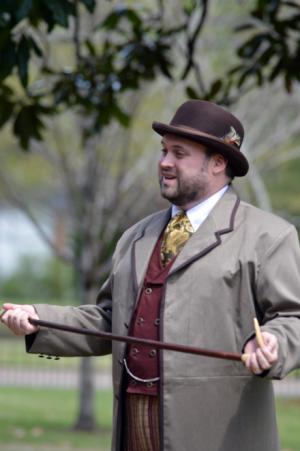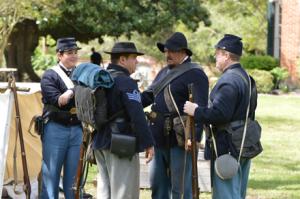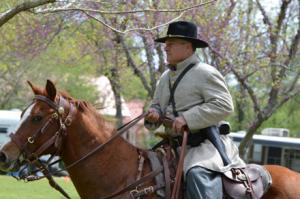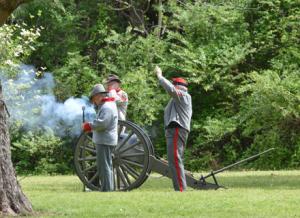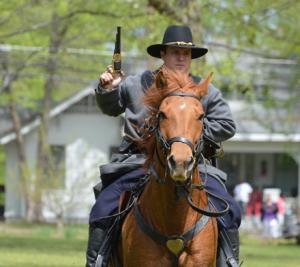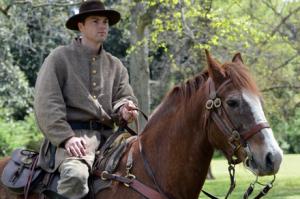Photos by Nancy Brannon
The second weekend in April (10-12, 2015) saw perfect spring weather, with dogwoods and redbud in full bloom – a beautiful setting for the 77th annual Holly Springs Home and Heritage Festival. Several antebellum homes were on the tour, including the Davis House at nearby Strawberry Plains Audubon Center, plus three churches in Holly Springs.
For the third year, the Behind the Big House tour showed visitors the living conditions and historic records of slaves living in Holly Springs. Michael Twitty, a Baltimore, Maryland based historian and writer, gave interpretations of African American history on the tour. The program interprets the lives of the enslaved through extant former slave dwellings. Joseph McGill, founder of the Slave Dwellings Project, was at the three sites over the weekend for guided tours. McGill talked about his nights spent sleeping in the beds in the slave dwellings and brought the slaves’ stories to life. On the tour were slave quarters at Magnolias (1852), Burton Place (1848), and Hugh Craft House (1851).
Headquarters of the home tour, Montrose, was the scene of a Civil War reenactment of Van Dorn’s Raid, which originally took place December 20, 1862. A small group of four mounted cavalrymen and four reenactors to fire the cannon gave visitors a glimpse of a Civil War skirmish. In December 1862, Union troops were stationed at Holly Springs, Mississippi under the command of General US Grant, who was headquartered in Oxford, MS. Confederate Cavalry, led by General Early Van Dorn, struck a raid on the Union troops, capturing over 1,500 Union soldiers and capturing as many supplies as possible.
Other reenactors were on hand to bring history to life. For example, Mr. William J. L. Holland, editor of The Reporter (now The South Reporter) talked with visitors about his experiences. He came to Holly Springs in 1870, but died from yellow fever in 1878.
Historic documents account: When news came to Holly Springs of the spread of yellow fever in Memphis, “the people of Holly Springs, declining to quarantine, became a society for relief… A few brave men organized a Relief Committee, with W.J.L. Holland, one of the editors of the Holly Springs Reporter, as chairman.”
On September 26, 1868, Holland’s press dispatch read: “The situation is growing worse. The two hospitals are full, and it looks as though every man must go down. After being recruited five times the relief committee numbered one. Five hundred persons now lie stricken with the fever, and there are yet five hundred more to take it; we pray for friends and frost.”
On the morning of October 25, the first funeral notice that had appeared since the epidemic began announced: “W. J. L. Holland, late chairman of the relief committee, departed this life at 2:30 a. m.; aged thirty-six years.” (genealogytrails.com)
The second weekend in April (10-12, 2015) saw perfect spring weather, with dogwoods and redbud in full bloom – a beautiful setting for the 77th annual Holly Springs Home and Heritage Festival. Several antebellum homes were on the tour, including the Davis House at nearby Strawberry Plains Audubon Center, plus three churches in Holly Springs.
For the third year, the Behind the Big House tour showed visitors the living conditions and historic records of slaves living in Holly Springs. Michael Twitty, a Baltimore, Maryland based historian and writer, gave interpretations of African American history on the tour. The program interprets the lives of the enslaved through extant former slave dwellings. Joseph McGill, founder of the Slave Dwellings Project, was at the three sites over the weekend for guided tours. McGill talked about his nights spent sleeping in the beds in the slave dwellings and brought the slaves’ stories to life. On the tour were slave quarters at Magnolias (1852), Burton Place (1848), and Hugh Craft House (1851).
Headquarters of the home tour, Montrose, was the scene of a Civil War reenactment of Van Dorn’s Raid, which originally took place December 20, 1862. A small group of four mounted cavalrymen and four reenactors to fire the cannon gave visitors a glimpse of a Civil War skirmish. In December 1862, Union troops were stationed at Holly Springs, Mississippi under the command of General US Grant, who was headquartered in Oxford, MS. Confederate Cavalry, led by General Early Van Dorn, struck a raid on the Union troops, capturing over 1,500 Union soldiers and capturing as many supplies as possible.
Other reenactors were on hand to bring history to life. For example, Mr. William J. L. Holland, editor of The Reporter (now The South Reporter) talked with visitors about his experiences. He came to Holly Springs in 1870, but died from yellow fever in 1878.
Historic documents account: When news came to Holly Springs of the spread of yellow fever in Memphis, “the people of Holly Springs, declining to quarantine, became a society for relief… A few brave men organized a Relief Committee, with W.J.L. Holland, one of the editors of the Holly Springs Reporter, as chairman.”
On September 26, 1868, Holland’s press dispatch read: “The situation is growing worse. The two hospitals are full, and it looks as though every man must go down. After being recruited five times the relief committee numbered one. Five hundred persons now lie stricken with the fever, and there are yet five hundred more to take it; we pray for friends and frost.”
On the morning of October 25, the first funeral notice that had appeared since the epidemic began announced: “W. J. L. Holland, late chairman of the relief committee, departed this life at 2:30 a. m.; aged thirty-six years.” (genealogytrails.com)
